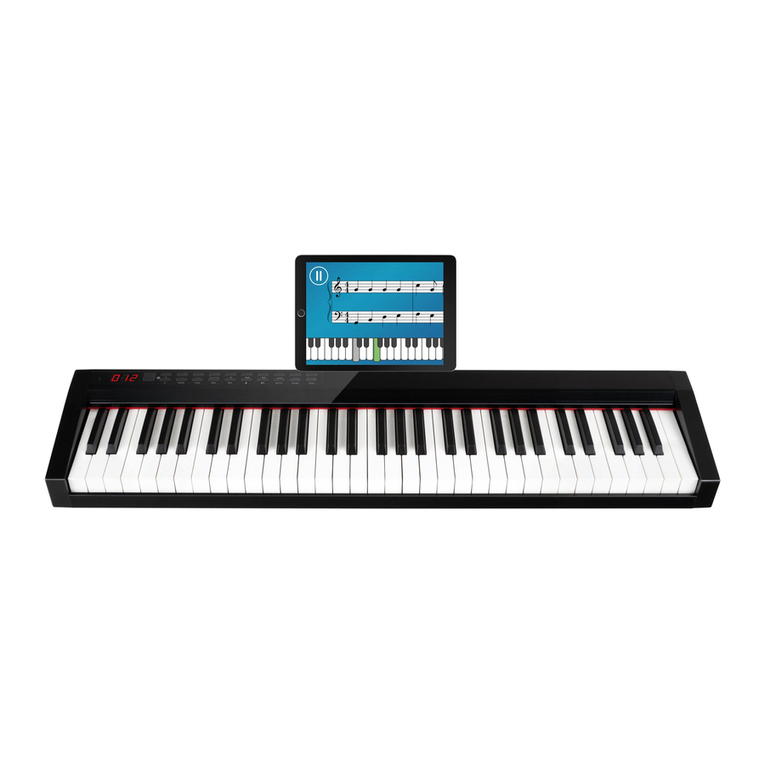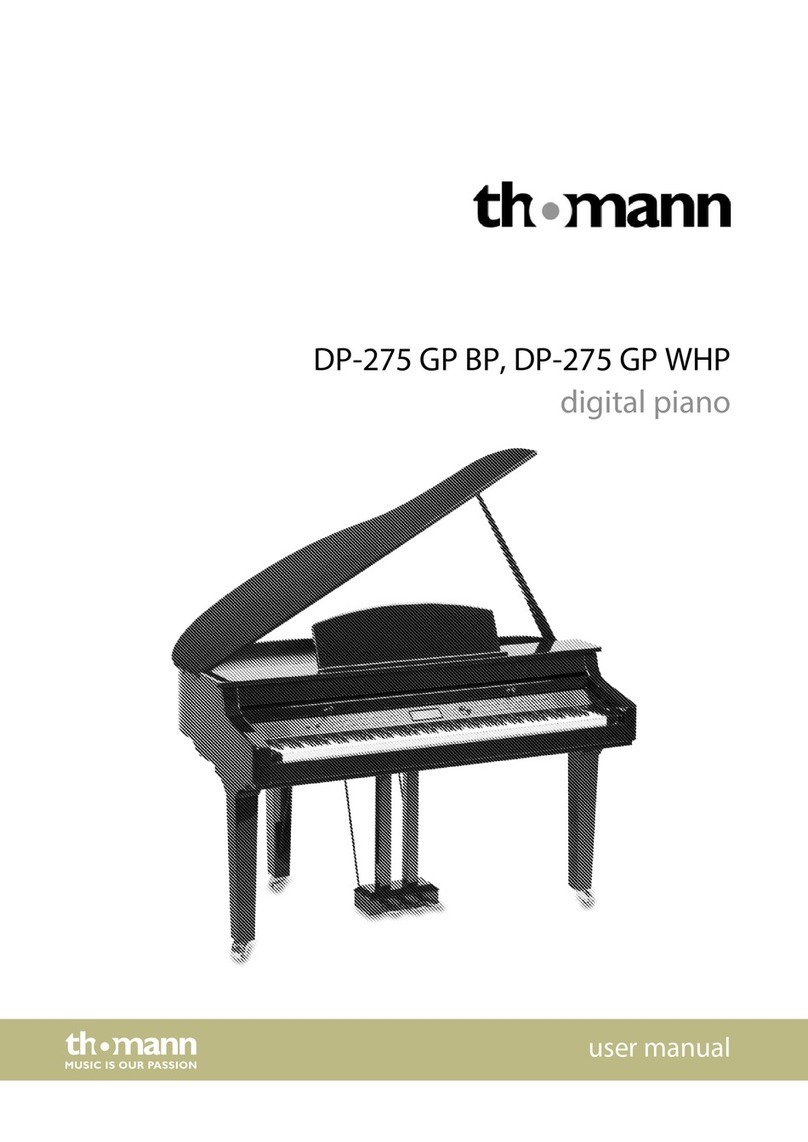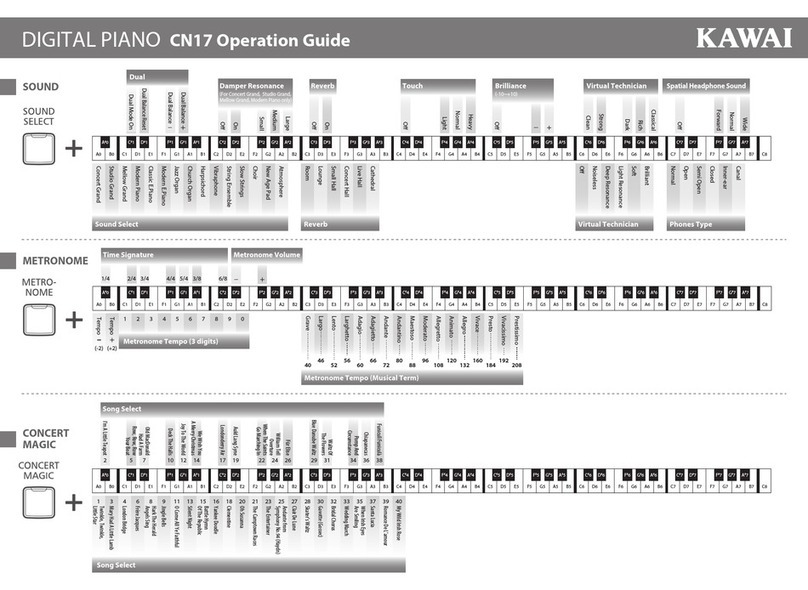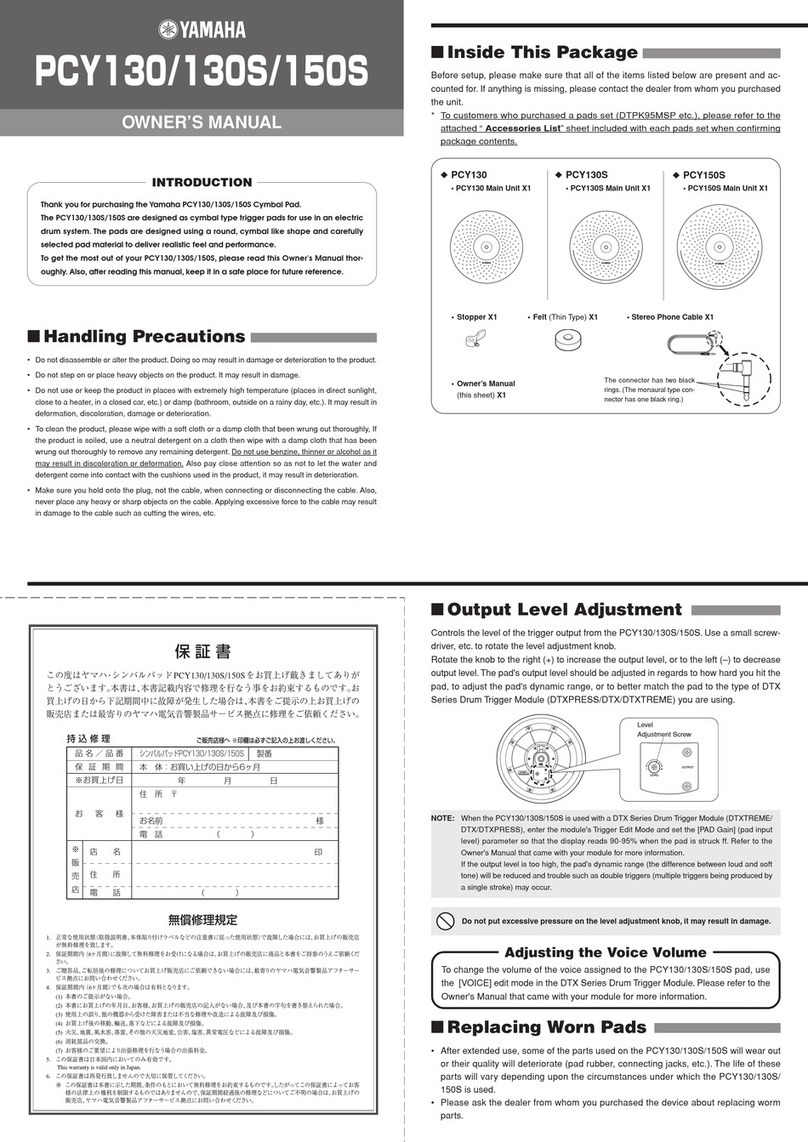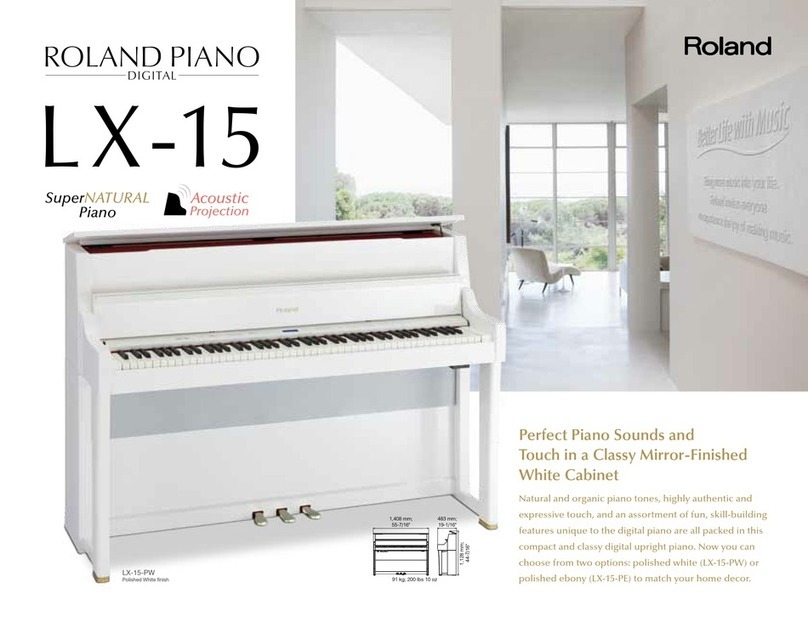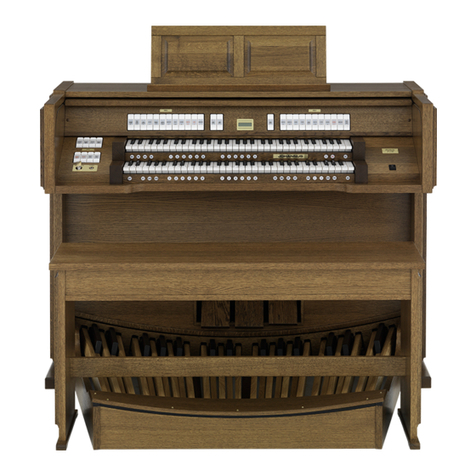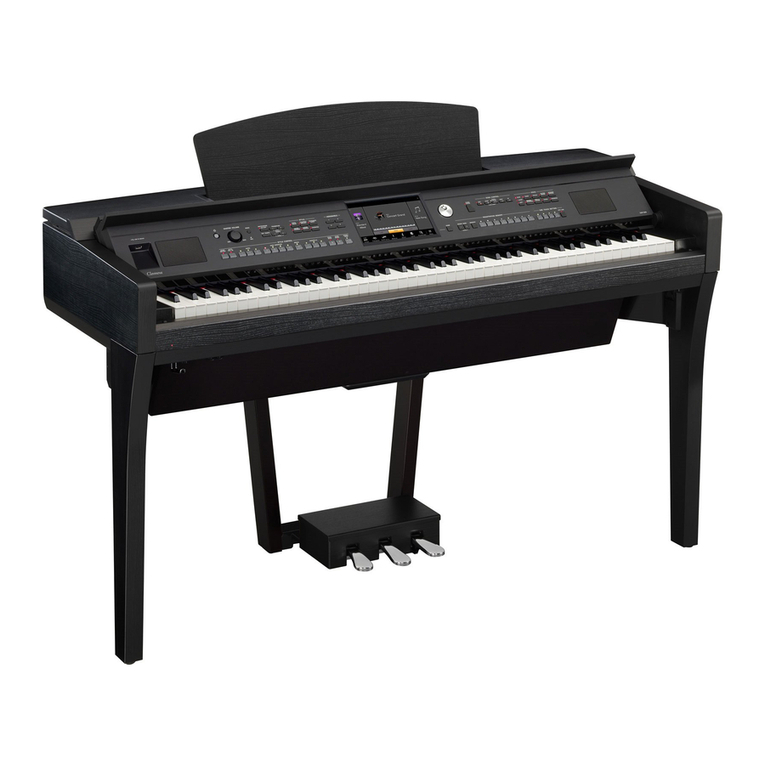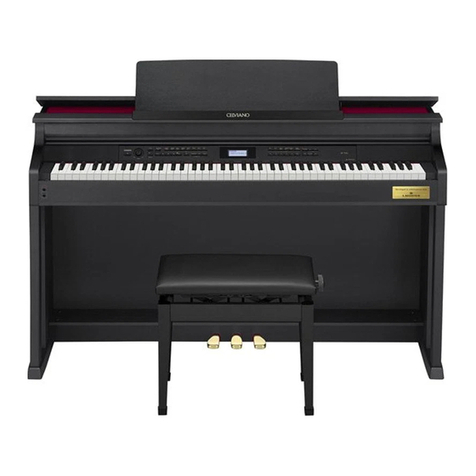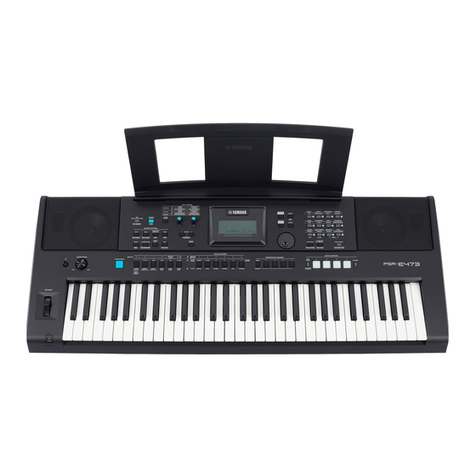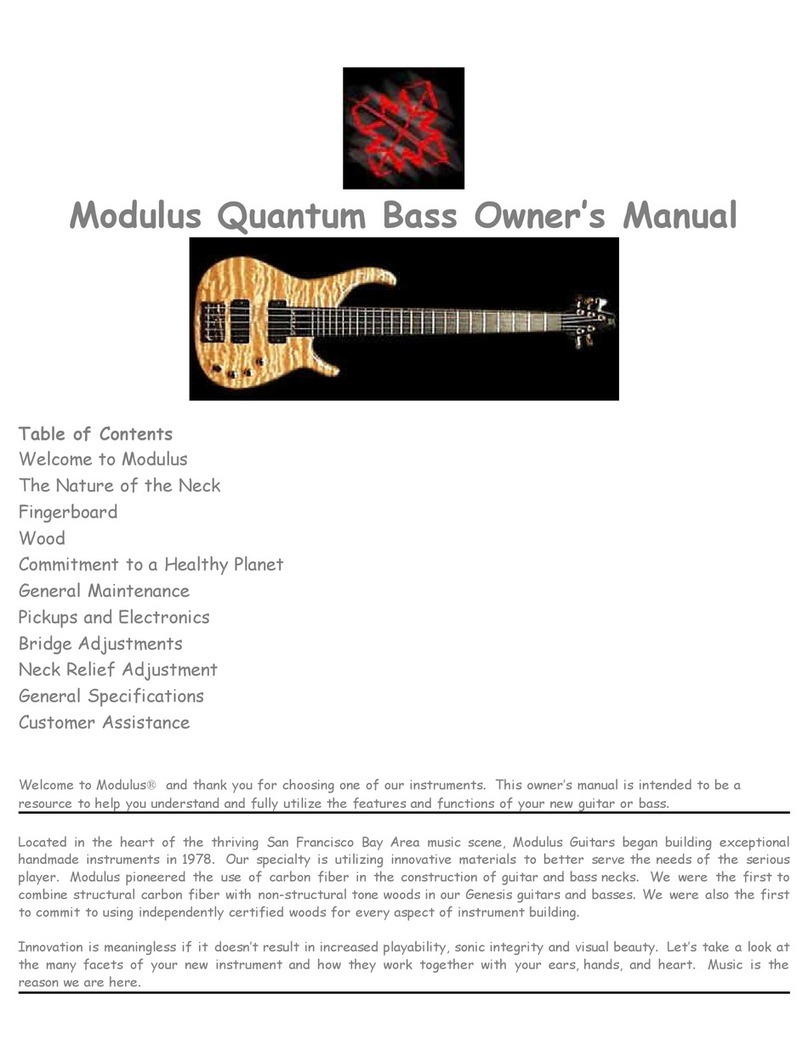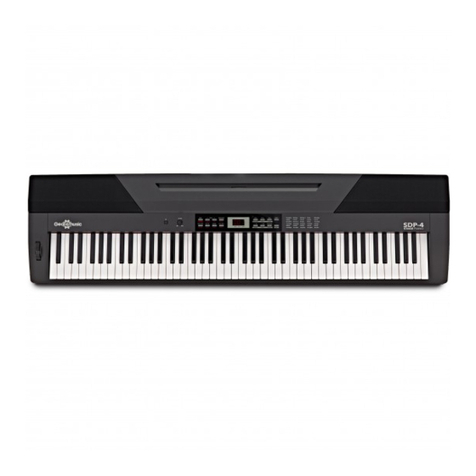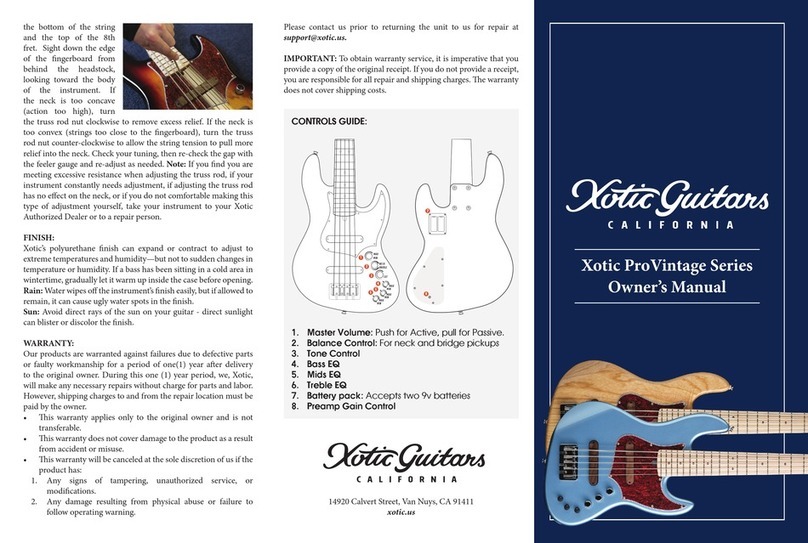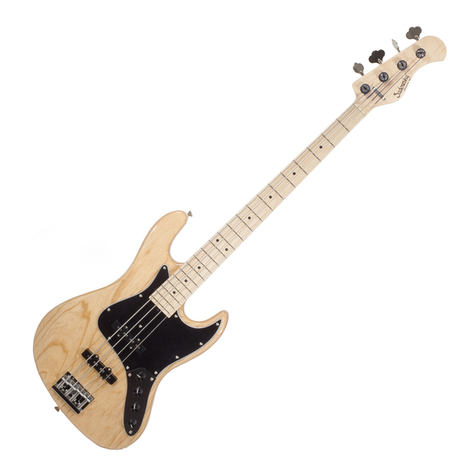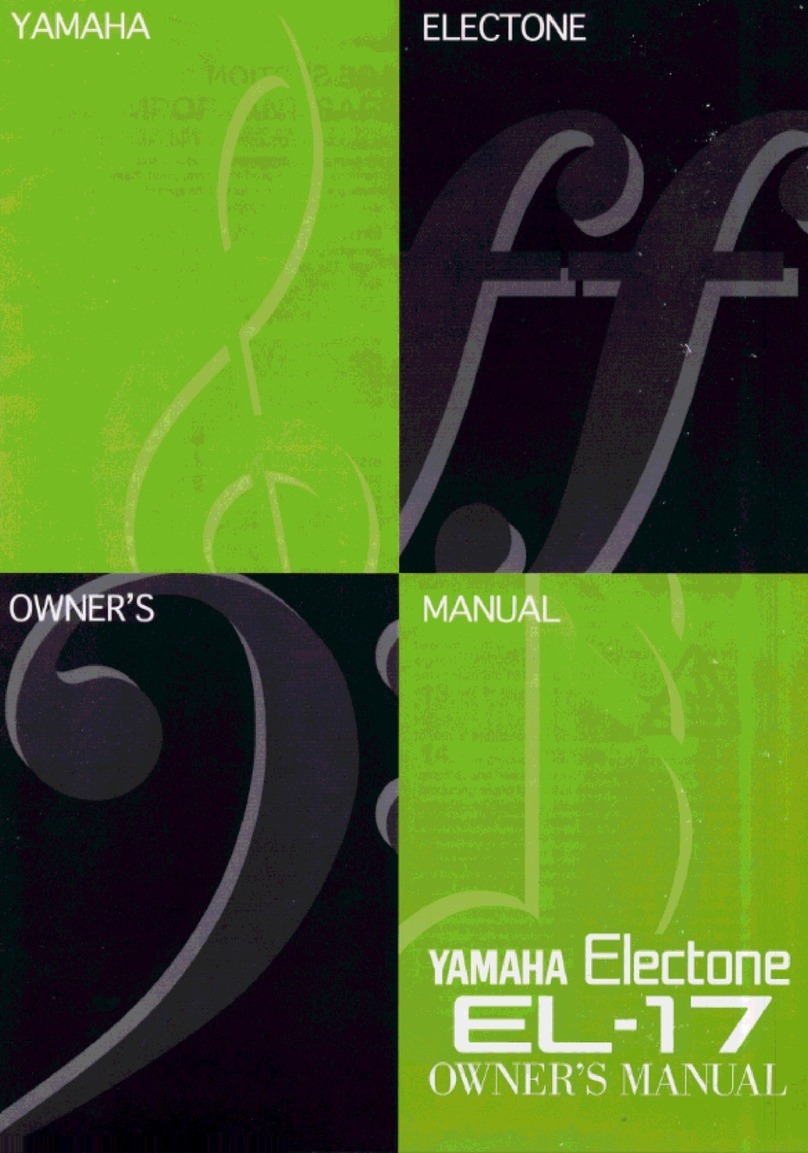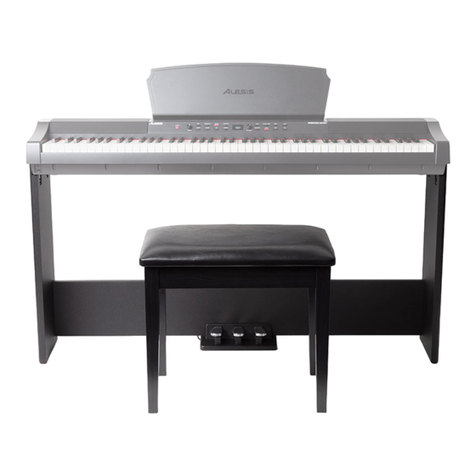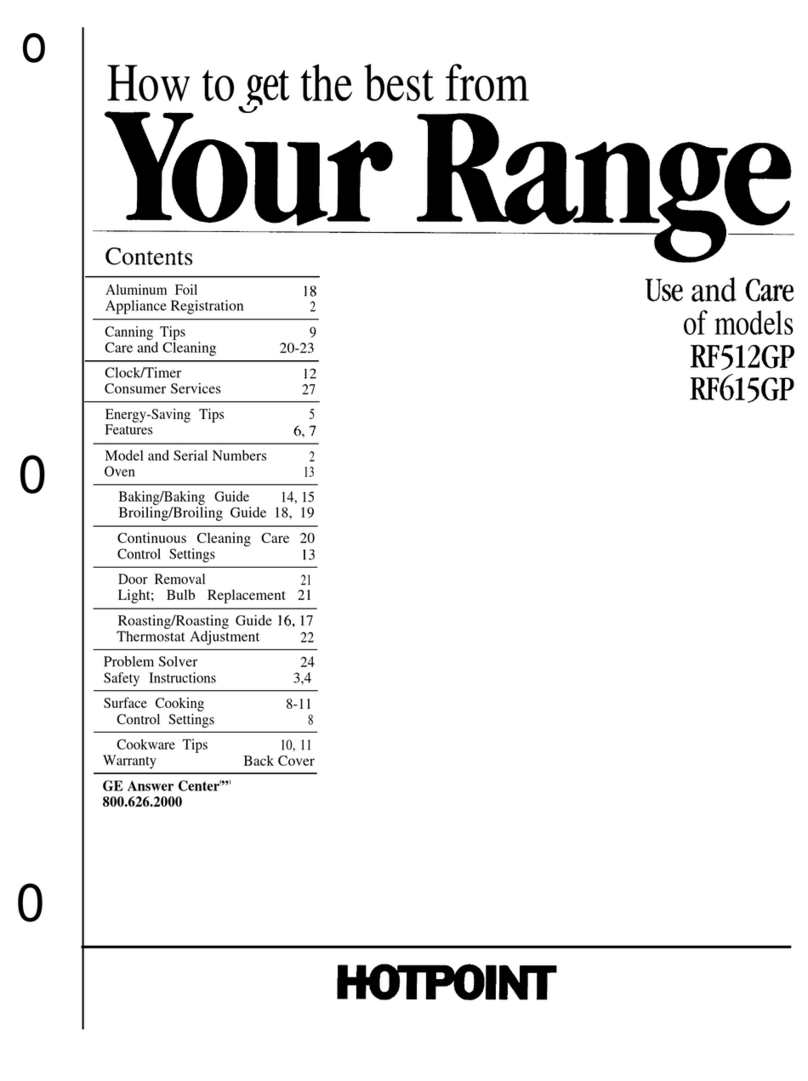Aeolian Company DUO-ART User manual

The
DUO-ART
Reproducing
Piano
DI/o-A
rt
Service Department
The AEOLIAN COMPANY
Aeolian
Hall
NEW
YORK
,,
,.


INTRODUCTION
The
object
of
this
pamphlet
is
to
give
aclear
and
concise
working
knowledge
of
the
Duo-Art
Pianola
Piano.
It
is
obvious
that
in
these
few
pages
the
aforementioned
SUbjects
will
have
to
be
treated
briefly,
and
that
agreat deal necessarily
will
have
to
be
taken
for
granted
that
the
mechanic
already
knows,
such
as
a
general
knowledge
of
pneumatics,
and
something
of
electricity.
There
is
nothing
really
complicated
or
intr;'icate
about
the
Duo-Art
and
once
its
principles
are
understood
it
will
be
realized
what
a
truly
remarkable
yet
simple
instrument
it
is. These
instructions
are based
upon
the
upright
Duo-Art
but
would
apply
generally
to
the
Grand
as
it
differs
only
in
design.
OPERATION
OF
DUO-ART
DYNAMIC
CONTROL
The
above
subject
will
be
treated
under
four
sub-headings,
namely:
1.
Dynamic
Step
Control
2.
Accompaniment
Control
3.
Theme
Control
4.
Manual
Control
DYNAMIC
STEP
CONTROL
The
Duo-Art
dynamic
control
has
15
steps
or
degrees
of
loudness,
and
with
the
fundamental
or
zero degree,
sixteen.
By
zero degree
is
meant
the
normai
Duo·Art.
The
zero
degree
is
not
called
astep.
To
put
it
simply,
it
is
the
foundation
or
baSIS
upon
which
all
the
higher
degr~es
are
built.
As
will
be
explained
later
in
the
Duo·Art
test,
this
zero degree
should
be
as
low
or
soft,
as
possible.
The
15
steps are
controlled
by
four
holes
in
the
tracker
bar
at
both
the
treble
and
bass
ends
of
bar,
above
the
regular
piano
notes.
(which
are
inoperative
with
the
Duo-Art
lever
"ON")
The
four
holes
at
bass end
of
bar
control
the
accompaniment
side
of
the
expression
box
and
the
four
in
the
treble
end
control
the
theme
side
of
the
box,
in
conjunction
with
additional
holes
in
the
bar
(B
Theme
&T
Theme
-
see
diagram
No.1
I.
These holes in
both
bass
and
treble
are
numbered
from
the
outside
in
(see
diagram
no. 1) Nos. 1, 2,
4,
8.
It
will
be
noticed
that
each
number
is
double
its
predecessor and
that
IS
exactly
what
they
are in
dynamiC
power.
From
the
tracker
bar,
these
dynamic
control
tubes
lead
through
two
cut-off
pouch
blocks,
(see
diagram
no. 2, no. 4) and
from
there
to
dynamic
valve
box,
(no.
281
which
controls
the
accord
ian
dynamics
(nos.
26,
27).
Each
of
these
accordian
dynamics
has
four
small
pneumatics,
each set
to
collapse a
certain
distance
by
small
adjusting
screws.
Number
one
in
both
accompaniment
and
theme
controls
the
top
or
smallest
pneumatic
of
the
four
and
collapses
1/16".
Number
two
on
each side
controls
the
next
pneumatic
and
collapses 1
/8".
Number
four
on
each side
controls
the
next
pneumatic
and
collapses 1
/4".
Number
eight on each side
controls
the
bottom,
or
largest,
pneumat
ic and collapses
1/2".
This
makes a
total,
with
all collapsed,
of
15116".
These
pneu·
matics
can
work
separately
or
in
combinations,
or
all
together.
There
are
15
combinations
possible
with
these
dynamics.
COMBINATIONS
Step
1. Valves
open
NO.1
Step
2. Valves
open
NO.2
Step
3. Valves
open
No.2
- 1
Step
4.
Valves
open,
NO.4
Step
5. Valves
open
. _
No.4
- 1
Step
6. Valves
open
NO.4
- 2
Step
7. Valves
open
No.4
- 2 - 1
Step
8. Valves
open
No.8
Step
9. Valves
open
No.8
- 1
Step
10. Valves
open
No.8
- 2
Step
11.
Valves open
NO.8
- 2 - 1
Step
12.
Valves
open
NO.8
- 4
Step
13. Valves
open
NO.8
- 4 - 1
Step
14.
Valves
open
No.8
- 4 - 2
Step
15.
Valves
open
NO.8
- 4 - 2 - 1
Number
1collapses
1/16
inch
Number
2collapses
1/8
inch
Number
4collapses
1/4
inch
Number
8collapses
112
inch
Total
collapse,
15/16
inch.
It
will
be
observed
that
the
accordian
dynamics
are
connected
by
a
rod
at
the
top
of
the
dynamics
to
an
arm,
which
when
pulled
down
opens
a
knife
valve (see nos.
16,
17\.
These
knife
valves
operate
over
port
holes leading
to
the
pump,
and
the
degree
to
which
these holes are
opened
determines
the
loudness
of
the
playing.
The
Duo-Art
normally
is
under
low
pump
tension,
drawing
in
the
atmosphere
through
a
spill
valve
(see
no.
18)
'.and
exhausting
through
the
pump.
This
spill
valve
is
completely
cut
off
by
either
the
accompaniment
or
theme
dynamics
at
the
10th
step.
Note
connection
of
spill
valve
to
both
the
accompani-
ment
and
theme
sides
of
expression
box,
and
as
either
knife
valve
is
pulled
down,
or
opened,
by
dynamics,
they
push against
rocker
arms
mounted
on
a
shaft
at
the
back
of
the
expression
box
and
the
knife
valve closes
off
the
intake,
or
what
is
termed
"spill".
ACCOMPANIMENT
CONTROL
A
very
important
feature
of
the
Duo-Art
dynamic
control
is
that
either
the
accompaniment
or
theme
side
of
the
expression
box
can
control
the
entire
keyboard,
or
one
can
control
the
bass
while
the
other
controls
the
treble,
or
vice versa.
This
gives great
flexibility
of
control
and
the
advantages
of
such asystem are
innumerable.
This
is
a
feature
found
only
in
the
Duo-Art.
The
regular
player
action
is
divided
between
the
43rd
&
44th
notes.
The
air
is
exhausted
from
player
action
into
chambers
Nos.
6&8
of
expression
box,
through
flap valves Nos. 9&
10
into
chamber
7,
and
down
through
channel
14
into
accompaniment
regulator.
Here
is
passes
through
knife
valve
16
and along chan-
nel
to
pump
where
It
is
exhausted.
The
theme
secondary valves (11 &12) are
normally
closed.
As
has
been
explained,
the
degree
to
which
knife
valve in
the
accompaniment
regulator
is
opened
determines
the
loudness
of
the
playing.
THEME
CONTROL
The
theme
dynamics
(No.
27)
control
the
degree
with
which
accented notes are
struck,
but
it
is
the
valves (11 &12)
which
are
controlled
by
holes
in
tracker
(marked
B
theme
& T
theme)
operating
theme
primary
valves (5)
that
determine
when
theme
shall
operate.
The
air
IS
exhausted
from
player
action
Into
chambers
(6
&8)
of
expression
box.
Now
theme
control
holes in
tracker
bar
are
opened
admlttrng
atmosphere
to
pouches
under
primary
valves
(5) raislllg
them,
and
putting
secondary
valves (11 &12)
under
suct
lon,
causing
them
to
drop
and
making
apassage
for
air
to
channel 13
where
it
follows
to
passage 15
into
theme
regulator.
Here It
passes
through
knife
valve
(17)
and
into
channel leading
to
the
pump,
where
it
is
exhausted.
-Showing
how
accompaniment
side can
control
the
treble
while
theme
side
controls
the
bass,
or
vice
versa.-
ACCOMPANIMENT
CONTROL
OF
TREBLE
The
air
comes
into
chamber
(8)
from
player
action,
and
theme
valve
(12)
being closed,
passes
through
flap
valve (101
into
chamber
(7)
through
channel
(14)
Into
accompaniment
reg·
ulator,
through
knife
valve
(16)
and
to
the
pump.
THEME
CONTROL
OF
BASS
Arr
comes
into
the
chamber
(6)
from
player
action
and
theme
valve
(11)
being
open
due
to
bass
theme
hole
in
tracker
being
opened,
the
air
passes
into
channel
13
and
then
through
pas-
sage
15
into
theme
regulator,
on
through
knife
valve
17,
and
to
the
pump.
It
should
be
understood
that
the
air
once
III
cham-
ber 7
cannot
return
to
chambers 6&8. Astudy
of
the
flap
valves 9&
10
will
be
self-explanatory.
MANUAL
CONTROL
Other
remarkagle features
of
the
Duo-Art
Pianol:J P,ano are
the
devices
for
its
manual
contro!.
This
system
is
equalled
by
few,
if
any.
and surpassed
by
none. ThiS system
is
controlled
by
five
levers,
four
of
which
are
in
front
of
the
keys and
one
In
the
spool
box.

HOW
TO
TEST
AND
ADJUST
THE
DUO-ART
This
test
will
be in aseries
of
steps
(12
in
number)
and
will
cover
all
points
necessary
far
a
thorough
inspection
and
adJust-
ment
of
the
instrument.
Before
beginning
the
Duo-Art
test,
it
is
advisable
to
see
that
the
piano
action
is
properly
adjusted,
and
a
few
words
here
on
that
subject
would
not
be
out
of
place.
As
is
well
known,
all
piano
actions
are
more
or
less
affected
by
extreme
dampness
or
by
dry
weather,
which
tends
to
alter
their
regulation,
thereby
making
it
difficult
for
the
player
to
function
properly.
Push
the
hammer
rail
toward
the
strings and
let
it
back
quickly.
If
the
hamme~
are
slow
in
returning,
the
action
is
damp
and
swollen,
and
must
be
remedied
before
going
further.
See
that
there
is
no
lost
motion
in jacks.
See
that
the
hammer
escapement
(let-off)
is
properly
adjusted;
it
should
average
1/8"
or
less
from
the
strings.
Now
see
that
the
hammers
check
about
5/8"
from
the
strings.
These are
the
most
essential
adjustments
in
relation
to
the
player
action
and
under
no
circumstances
should
they
be over-
looked.
The
more
the
mechanic
knows
of
piano
action
regulation
the
finer
results he can get
from
the
player
action.
Now
see
that
there
is
no
lost
motion
between
the
player
action
pitmans
and
the
wippens
on
the
piano
action.
See
that
the
stroke
on
the
play-
er
is
the
same
as
the
hammer
check
on
the
piano
action.
This
is
a
common
adjustment
to
all
player
actions
and need
not
be ex-
plained
here.
Make
sure
player
action
is
screwed
fast;
all tubes
are secure, rods
connected,
and
working
freely.
The
first
lever
on
key
front
to
the
left
is
called
the
theme
modulating
lever.
This
lever
controls
the
degree at
which
theme
notes
are
played,
but
unless
worked
in
conjunction
with
the
two
little
levers
on
the
key
front
next
to
the
right,
one
above
the
other,
there
is
no
noticeable
result. As
will
be
noticed
in
the
dia-
gram,
the
theme
modulating
lever
is
connected
to
the
theme
knife
valve
regulator,
and
as
the
lever
is
pushed
to
the
right,
it
pulls
down
and
opens
knife
valve
(17)
but
as
long
as
valves
11
&
12
are
closed,
it
has
no
effect.
These
two
levers
to
the
right,
one
above
the
other,
control
theme
primary
valves
(5).
The
topmost
one
controls
the
bass,
and
the
bottom
one,
the
treble.
The
modulating
lever
controls
the
degree,
and
these bass and
treble
levers,
the
time,
when
the
theme
shall
operate.
The
next
lever
is
called
the
Temponamic
Lever.
This
controls
the
tempo
by
its side
motion,
and
accompaniment
expression
by
its
rotating
motion.
By
turning
this
disc
to
the
right,
it
pulls
down
on
arm,
reg-
ulating
the
knife
valve, and
opens
a
port
leading
to
the
pump.
The
more
this
port
is
opened,
the
louder
the
playing.
The
fifth
control
is
the
Duo·Art
lever
in
the
spool
box.
This
lever
should
be in
the
"Duo-Art
ON"
position
for
all
Duo-Art
rolls
to
be
played
automatically.
To
play
Duo-Art
rolls
with
personal
expression,
have
this
lever
in
the
central
position.
For
all
other
88·note
rolls,
have
this
lever at
"OFF".
When
the
Duo-Art
lever
is
thrown
to
the
center,
or
neutral
position
(or
to
the
OF
F
position)
the
little
pneumatic
(25)
collapses
to
the
point
adjusted
to
by
the
screw
in
the
moveable
board
of
t
he
pneumatic
and
pulls
down
on
the
arm
controlling
the
accompaniment
knife
valve,
thus
making
the
zero degree
louder
when
the
Duo-Art
lever
is
at
"OFF".
It
has
no
other
function.
Make
sure
your
test
roll
measures eleven and one
quarter
inches
in
width.
If
not,
use a
roll
that
does. Have
music
spool
shaft
in
center
of
shifting
cam
and
shifting
pneumatics
centered.
These are
adjusted
on
shifting
rod
at
back
and
left
of
spool
box,
by
asmall
turnbuckle.
Now
with
roll
running,
adjust
tracker
lugs
so
that
they
just
barely
touch
the
edge
of
the
roll.
TRACKING
DEVICE
Step
3.
SUSTAINING
PEDAL
Step
4.
Follow
tests
on
roll
in
rotation.
With
tempo
indicator
at 70,
roll
should
run
seven
feet
per
minute.
Tempo
should
cut
off
with
indicator
at
extreme
left
and
just
start
at ten.
To
run
faster,
tighten
spring
on
governor;
to
run
slower,
weaken spring.
TEMPO
DUO-ART
LEVER
"OFF"
Step
1.
See
that
the
gearing is
properly
oiled,
and
all
set screws
tightened.;
Set
the
re-roll
and
play
brakes.;
See
that
the
sprocket
chains
are
not
too
loose
nor
tight.
Have all
parts
on
wind
motor
free
but
not
noisy.
Use
no
oil
on
the
wind
motor.
Pump
out
tracker
bar
and
insert
test
rolLin
spool
box.
-~
ELECTRIC
MOTOR,
PUMP
AND
CONNECTIOrzS
Step
2. "
Connect
electric
cord
to
conduit
in
back
of
piano
and
make
sure
the
current
is
on.
Be sure
the
motor
is
proper
for
local
current.
Have
motor
hand
level
and
with
enough
tension
on
belts
so
that
they
will
not
slip.
See
that
motor
is
properly
lubricated
and
set screw
in
the
pulley
is
tight.
See
that
the
armature
on
the
motor
rotates
freely.
Now
turn
on
switch
-
if
motor
does
not
start
instantly,
turn
off
switch
or
motor
will
burn
out.
Notes
on
Duo-Art
Motors
There
are
two
types
of
motors
used;
1/4
horsepower
motor
being
used
with
the
six
feeder
type
pump,
and
1/8
horsepower
with
the
four
feeder
pump.
Both
motors
run
at
1150
rpm
in
both
AD
and
DC
models.
All
AC
motors
are
60
cycle.
To
change
rotation
of
DC
motors,
reverse leads
at
brush
box.
To
change
rotation
of
AC
motors
interchange
two
leads
coming
through
bushing
cover.
(Step 2
continued}
A
fter
motor
has been inspected, have
idler
on
pump
belts
set reasonably
tight
and
on
slack side
of
belts.
Now
see
that
grease cups
on
pump
are
filled
and
turn
plungers
down
a
bit
to
force
grease
into
bearings. Have
pump
quiet
and
time
pulsations.
A
pulsation
is
the
opening
and
closing
once,
of
one
feeder.
Six
feeder
type
pump
should
pulse 70 -
72
times
per
minute,
and
the
four
feeder
type
120
times
per
minute.
To
change speed
either
way
it
would
be necessary
to
change
the
size
of
pulley
on
motor.
Duo-Art
motors
are
furnished
with
proper
size
pulley
to
give
required
pulsations,
and
before
any
change
of
pulley
is
made,
it
would
be advisable
to
make
certain
that
the
voltage
of
current
supplied
is
correct.
-
SPOOL
BOX
GEARING
AND
CONNECTIONS
Step
5.
The
sustaining pedal
is
controlled
by
second
hole
in
bass
end
of
tracker
bar.
Flat
dampers
should
clear
strings
about
1/8"
with
pedal
on.
Dampers
should
come
back
to
strings
between
each
bridge
in
the
test
roll
with
tempo
set
at
70.
It
will
be
noticed
that
the
sustaining
pedal,
soft
pedal
and
dynamics
get
their
supply
from
a
pneumatic
tension
regulator.
This
regulator
keeps
their
supply
under
even
tension.
This
is
done
by
aspring
attached
to
it.
Adjust
spring
so
that
pedals
and
dynamics
work
quickly
but
not
noisily.
To
operate
faster,
strengthen
spring;
slower,
weaken
spring.
Tracker
box
gearing and
connections.
Electric
motor,
pump,
and
connections.
Tracking
device.
Tempo.
Sustaining
pedal.
Soft
pedal.
(Hammer-rail
liftl
Dynamics.
Accompaniment
zero
setting.
Theme
zero setting.
Notes.
Dynamic
Chord
test.
Re-roll.
IMPORTANT
STEPS
IN
TEST
Step
1.
Step
2.
Step
3
Step
4
Step
5.
Step
6.
Step
7.
Step
8.
Step
9.
Step
10
Step
11.
Step
12.

SOFT
PEDAL
Step
6.
The
soft
pedal
is
contrOlled
by
the
last
hole
in
the
treble
end
of
the
tracker.
On
uprights,
rail
should
move
to
1/8"
from
the
strings.
On
grands, rail
should
lift
5/8
from
normal
position.
DYNAMICS
Step
7.
ACCOMPANIMENT
(Duo-Art
lever
"ON'"
The
accompaniment
dynamics
are
operated
from
the
bass
end
of
tracker
bar,
above
ordinary
piano
notes,
and
are
numbered
1,2.4,8.
These
dynamics
should
operate
in
order
given.
THEME
These
dynamics
are
operated
by
four
holes
in
the
treble
end
of
tracker
bar
above
piano
notes
and are
the
same
as
accompani-
ment
dynamics,
1,2,4,8,
and
should
operate-
in
order
given.
ACCOMPANIMENT
SETTING
OF
ZERO
DYNAMIC
Step
8.
Tempo
at
80
Warning:
This
is
the
most
delicate
and
Important
adjustment
in
the
entire
test and great care
must
be
taken
in
this
adjustment.
On
its
setting
depends
the
ability
of
the
instrument
to
play
the
soft
runs
and
trills
in
the
music
so
much
desired
by
all
music lovers.
First
throw
off
electric
switch
and
see
that
regulator
springs
(21 &
22)
have a
little
tension,
just
enough
to
keep
them
from
rattling.
Use
adjusting
rings (23 &241.
Now
see
that
all
tension
springs
on
the
expression
box
have a
little
tension
on
them.
See
that
the
rocker
arms
controlling
spill valve
when
pushed
back
move
forward
again
quickly.
Also
have arms
regulating
knife
valves
come
back
quickly.
Have
all
rods
and
shafts
on
expression
box
free
from
bindll1g
and
squeaking. Avery
important
thing
to
watch
is
that
there
is
no
pressure against
knife
valve
regulating
arms,
otherwise
the
knife
valves
would
open
a
little
and
this
would
make
it
impos-
sible
to
properly
adjust
zero
dynamics.
Also,
there
should
be no
slack
in
arms resting on
knife
valve regulators
as
this
is
just
as
bad
as
the
previous
condition
mentioned.
The
little
leather
adjusting
nuts
on
top
of
accordion
dynamics
(26
&27)
on
rod
to
knife
valves
should
not
be
tampered
with
as
they
are set
properly
at
the
factory
and seldom
if
ever need resetting.
If
the
accordion
pneumatics
have a
little
slack
or
sag,
from
leather
stretching,
it
is
permissible
to
take
this
up
on
these leather
nuts,
being
careful
not
to
put
too
much
tension
on
the
rod
as
this
will
open
knife
valve and
this
adjustment
must be made
before
setting
accompaniment
Or
theme
regulators
as
it
will
throw
out
their
setting
if
done
after
they
are adjusted.
It
is,
however,
rare
that
these nuts
will
need any
adjustment.
Throw
on
electric
switch
and
observe sottness
of
notes
on
accompaniment
tests.
It
will
be
noticed
that
sustaining pedal
is
on
with
the
first
run
of
notes,
making
them
easier
to
play
and
off
with
the
next
run.
Notes
should
play
very
softly
and
on
the
next
run
should
miss
most
at
them,
Or
strike
an
occasional
note.
The
third
run
of
accompaniment
test
is
similar
to
the
first..
If
on
the
second
run
of
ndtes'io
accompaniment
setting
at
zero
dynamic
all
notes
strike
full,
playing
IS
too
loud
and
must
be softened.
To
soften,
adjustment
is
made
on
knife
valve
adjust-
ing screw
(19)
and
next
to
this
adjusting
screw
is
asmall set
screw (19-a).
This
must
be
loosened
before
trying
to
turn
adjust·
ing screw
or
thread
will
be
stripped.
Immediately
after
adjusting
screw is set,
tighten
lock
screw
as
there
'is
a
little
play
in
knife
valve
shaft
unless
this
is
tightened
and
it
would
be
impossible
with
lock
screws loose
to
make
fine
adjustment.
On
uprights,
to
soften,
turn
adjusting
screws
to
left,
and
to
the
right
to
make
louder.
On
grands
it
is
just
the
reverse,
as
the
expression
boxes
are
installed
just
the
opposite
way.
It
takes
only
aslight
turn
of
the
adjusting
screw
to
make
agreat
difference.
In
making
this
adjustment
always
get a
blank
setting
on
the
test
roll,
have
motor
running
and
tempo
cut
off.
Watch
accomp-
animent
regulator
pneumatic
while
setting
screw;
softening
causes
it
to
open
and
the
reverse causes
it
to
collapse.
Adjust-
ment
can be gauged
accordingly.
Patience
is
required
in
making
this
adjustment,
but
with
a
little
practice
it
comes
readily.
As
will
be observed,
knife
valve has
to
be
adjusted
to
take
first
run
of
notes
softly,
but
skip
or
miss
most
of
notes
on
second
run.
TO
SET
SOLO
OR
THEME
DYNAMIC
Step
9.
The
theme
adjustment
is
made
on
adjusting
screw
similar
to
accompaniment
side
(see
No.
20)
It
also
has
aset screw (20-a)
which
must
be
loosened
while
adjusting
screw
is
being set, and
tightened
immediately
The
setting
of
theme
side
is
dependent
upon
the
setting
of
the
accompaniment
as
no
matter
where
the
latter
is
set,
theme
must
be
one
degree
louder.
Naturally,
the
conception
of
"one
degree"
will
vary
with
the
individual,
but
a
uniformly
safe
rule
to
follow
IS
to have
the
theme
regulator
pneumatic
collapse
1/8"
more
than
the
accompaniment
pneumatic.
Never have
theme
pneumatic
even
with,
nor
opened
more,
than
accompaniment.
NOTES
Step
10.
Notes
should
all
strike
evenly
and
softly
on
thiS test. We
will
not
go
into
adiscussion here
of
the
ordinary
note
troubles
as
the
mechanic
is
unquestionably
able
to
handle
any
trouble
aris-
ing
with
them.
DYNAMICS
CHORD
TEST
Step
11.
These
chord
tests
show
if
dynamics
build
up
evenly.
It
accompaniment
setting
of
zero
dynamic
was
properly
adjusted,
the
first
three
chord
tests
will
be
found
very near
right.
Aslight
adjustment
on
the
regulator
springs
121
&
221
is
permissible,
but
any
radical
adjustment
will
throw
accompaniment
setting
of
zero
dynamic
out,
and care
must
be
taken
to
avoid
this.
It
may
be necessary
to
meet
chord
tests
to
reset
accompaniment
and
theme
zero
dynamics
a
little,
The
last eight
chord
tests
show
evenness
of
dynamics
in
building
up,
and
if
pump
has been
properly
tested and all
adjustments
made
correctly
up
to
this
point,
instrument
shoVld meet these test.
Followll1g
on
the"
lest
roll
are
two
selections
of
music
es-
pecially
selected
to
tryout
the
responsiveness
of
the
dynamic
mechanism.
RE-ROLL
Step
12.
The
re-roll IS
operated
by
the
first
hole
in
the
bass
end
of
the
tracker
bar,
and
throws
the
gearing
into
reverse
and
cuts
off
air
to
action
slide valve (291.
If
slide valve (29)
did
not
completely
cover
the
port
on
re-
roll,
the
plano
would
play
in
the
re-roll mode.
This
seldom
happens,
but
It
is
possible.
The
mechanic
should
always
rem-
ember
,In
locating
trouble
that
there
is
only
one sure
m,nhod
to
follow
without
tearing
everything
to
pieces, and
that
is
to
lo-
cate
the
trouble
by
aprocess
of
elimi'nation.
